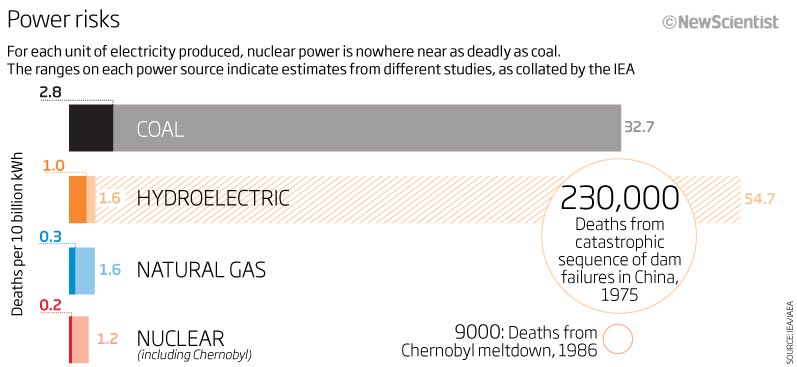One night of at the end of March in 1979 we went to a party in Queens. Brenda, my first wife, is an artist and was painting and studying in New York. Our friends included many of the younger artists working in New York at the time. That day it had just been announced that there was a possible meltdown at a nuclear reactor at a place called a Three Mile Island , near Harrisburg Pennsylvania.
I was amazed that some people at the party were excitedly imagining that the scenario in the just released film ‘The China Syndrome’ was about to be realised; and thousands of people would be killed.
They actually wanted this to happen. The death of thousands of people would put an end to nuclear power for ever. They wanted nuclear power gone on principle. It was good thing if it proved unsafe. If it proved to be safe, or if only a few were killed, it would be disappointing.
I remember suggesting that the direct and indirect death of thousands of people every year has done nothing to minimise the use of coal, oil or gas to generate electricity. Since that time the Chernobyl disaster has added 9000 nuclear deaths worldwide but this is only a fraction of the annual deaths due to coal based electricity generation in the US alone.
New Scientist has published a wide range of articles covering all aspects of the current issues arising from the natural disaster and related nuclear crisis in Japan. Among these is the following self-explanatory diagram.
Click on the above image to follow the link.
But of course I was wrong in thinking that rationality would prevail.
The Three Mile Island incident effectively stopped further expansion of nuclear power in the US for many years. This was despite the fact that when all the hype and a misinformation were finally put to rest it was determined that there had been no injury to anyone; let alone any deaths.
The media circus was unbelievable. Jane Fonda the star of ‘The China Syndrome’ teamed up with consumer advocate and Presidential hopeful Ralph Nader and went on a campaign trail opposing any further use of nuclear energy. Senator Edward Kennedy then jumped on the bandwagon. If there was a parade in town he wanted to be out in front, leading it.
Just 10 years earlier Kennedy had been involved in another island disaster when he drove off a bridge at Chappaquiddick Island and his passenger, Mary Jo Kopechne, drowned in very strange circumstances. Here was a chance to regain some popular appeal. When the media circus finally ran out of steam and the reality of Three Mile Island was revealed, a famous bumper sticker appeared across the Nation: More people died at Chappaquiddick than at Three Mile Island . It didn’t mention Kennedy but his Presidential hopes, already seriously damaged by the death, were gone forever.
Apart from Kennedy there was no other victim of the meltdown at Three Mile Island; unless you count the leading nuclear physicist Edward Teller, who claimed that a heart attack he suffered was as a direct result of the nonsense of being perpetrated by Jane Fonda:
‘I suffered a heart attack. You might say that I was the only one whose health was affected by that reactor near Harrisburg. No, that would be wrong. It was not the reactor. It was Jane Fonda.’
Now we’re seeing the same media circus, with the same elephants in the room (like deaths due to fossil fuel) and a new generation of antinuclear advocates; dusting off the old bandwagon as a result of the huge earthquake and tsunami in Japan; and the following aftershocks.
It is informative to deconstruct some of the present media interest in the Fukushima issues arising from the tsunami. It is notable that the tsunami deaths are almost always mentioned in the context of the technical problems at the power plant as if the plant had something to do with the deaths; or the deaths with the problems at the plant. Many of those living next door to the reactor are dead; but they were not killed by the reactor. Indeed unlike many of their neighbours, workers at the Fukushima nuclear plant were protected from the force of the wave by its very substantial structure.
Until the dust settles we will not know sufficient to determine the extent of the damage. But informed sources continue to rate the present incident as a far less significant than Chernobyl. Yet the media, and elements in our Government, encouraged Australians to leave Tokyo and other places distant from Fukushima because of the nuclear risk; that obviously looms large in the collective imagination.
It is very likely that oil, gas and coal will prove to be responsible for far more environmental damage and death than will Japan’s damaged nuclear reactors. Drowning and physical trauma; entrapment and location of victims; disease due to lack of fresh water and food; and cold due to lack of energy; should be of far more concern than leaked radiation.
Should anyone be killed by the damage to the nuclear facilities, and to date no one has been, it will pale into insignificance against the appalling death rate in the surrounding countryside caused by the wave.
Time will tell.

